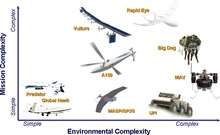Uncrewed vehicle
An uncrewed vehicle or unmanned vehicle is a vehicle without a person on board. Uncrewed vehicles can either be remote controlled or remote guided vehicles, or they can be autonomous vehicles which are capable of sensing their environment and navigating on their own.

Various uncrewed vehicles
Types
There are different types of uncrewed vehicles:[1]
- Remote control vehicle (RC), such as radio-controlled cars or radio-controlled aircraft
- Unmanned ground vehicle (UGV), such as the autonomous cars, or unmanned combat vehicles (UCGV)
- Unmanned aerial vehicle (UAV), unmanned aircraft commonly known as "drone"
- Autonomous spaceport drone ship
- Unmanned surface vehicle (USV), also known as "surface drone", for the operation on the surface of the water
- Unmanned underwater vehicle (UUV), also known as "underwater drone", for the operation underwater
- Uncrewed spacecraft, both remote controlled ("uncrewed space mission") and autonomous ("robotic spacecraft" or "space probe")
gollark: That doesn't scale linearly with mass number, BEE.
gollark: It isn't known to be denser than tungsten.
gollark: No? That would be stupid.
gollark: Alternatively, GTech™ stabilized black holes™.
gollark: I recommend tungsten, as it's pretty inert.
See also
- Vehicular automation
- Optionally piloted vehicle
- Automatic Train Operation (ATO), such as the "Driverless Train"
- Robot
References
- Huang, Hui-Min (September 2004). Autonomy Levels for Unmanned Systems (ALFUS) Framework. Volume I: Terminology. National Institute of Standards and Technology.
This article is issued from Wikipedia. The text is licensed under Creative Commons - Attribution - Sharealike. Additional terms may apply for the media files.
